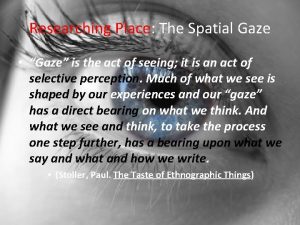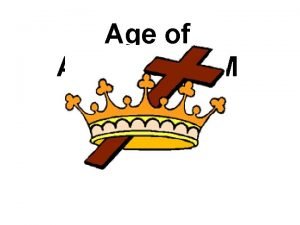Divine Gaze Daran and the Role of the





























- Slides: 29

Divine Gaze: Darśan and the Role of the Visual in Hinduism

Darśan “India is a visual and visionary culture, one in which the eyes have a prominent role in the apprehension of the sacred” - Diana L. Eck, Darśan

Darśan In Hinduism, spirituality is accomplished through Darśan, the act of looking at a deity by means of a likeness or image. This concept has no parallel in traditional Western religious practices.

Seeing as Fulfillment n Darśan allows devotees to know the deity in a personal way, thus offering complete spiritual fulfillment. It a reciprocal act: an interaction in which one desires to see and be seen by the deity. n

Seeing as Touching n Seeing takes on an extrusive role in Darśan. One uses the eyes to reach out and “touch” the object of one’s gaze. n The act is initiated not by the devotee, but by the deity itself, who reaches to the devotee through looking.

Seeing as Power Seeing holds immense power in Hinduism. The vision of a deity blesses the object of its gaze n n Looking can even act as a form of protection, as with Ghandari in the Hindu epic Mahabharastra

Equality through Seeing n Through Darśan, one can be on the same level as the deity for the moment of contact, resulting in an intense spiritual experience.

Darśan Between People n The religious notion of Darśan also exists in India’s social world, where there is a heightened awareness of visual interaction. n n One can take the Darśan of a revered or important person. This allows one to be on the same level as the individual and enjoy his or her private visual recognition.

The Nature of God The Hindu nature of God cannot be described as either monotheism or polytheism. Rather, it involves a slippery mix of the two in which God encompasses both a single Supreme being and multiple beings.

The Nature of God One might refer to this belief system by saying that each god is Supreme in its own time. n n When engaged in Darśan, a devotee considers whatever deity he or she is seeing to be the ultimate God.

The Nature of God Hinduism is a pluralistic religion n n Jesus is worshiped along with other deities. Hindus see no contradiction in this combination. n

Humans as the Supreme Being Divinity is not restricted to deities, but can also take human form. n n The Radha Soami sect offers one example of this: they believe that salvation can only be attained from taking the Darśan of a divine guru.

Iconic and “Aniconic” images n The Darśan of a deity can be received from an iconic form that resembles a person, as well as from an “aniconic” form in which the image is a symbol. Śiva as Nataraj Śiva Linga

Pilgrimage In addition to taking the Darśan of deities and humans, devotees also go on pilgrimages to take the Darśan of auspicious places. n n They do this not to see the picturesque beauty, but to engage in a spiritual gaze of the site.

Svayambhu: “Self Appearing Images” n Not all religious images are created by human hands. Svayambhu are deities that appear naturally in physical forms. Svayambhu Linga at Kedarnath

Prānapratisthā: “Opening of the Eyes” One of the most evident examples of vision’s prevalent role in Hinduism can be found in the way idols are created. n n Prānapratisthā, the point at which the eyes of an image are drawn, carved or uncovered, is considered the point at which the life of the deity is breathed into the object.

Pūjā n Because the diety is believed to be alive in the physical idol, worship or “puja” includes offerings of water, sweets, incense and other items.

Technology and Religion: Chromolithography n With the invention of chromolithography, a new aspect of worship was established. No longer are deity images limited to sculptural idols.

Technology and Religion: Chromolithography n Sculptural deities sit with framed chromolithographs in Hindu shrines.

Technology and Religion: Photography n n In India, photography has been incorporated into spirituality. Photographs of saints and gurus are used in Hindu worship.

Technology and Religion: Photography n. Photographs are used as a means of honoring and maintaining a spiritual connection with deceased loved ones. image from Pinney, 1997

Technology and Religion: Photography Though it is not a photograph, this image demonstrates the blending of photography into religion n n image from Pinney, 1997 The deities are posing as if having their picture taken.

Technology and Religion: Cinema n In India, cinema has traditionally held close ties with religion. The mythical and devotional genres feature films based on the lives of deities and devotees, respectively. n Phalke’s “Raja Harischandra, ” the first full-length Indian film and part of the mythical genre

Technology and Religion: Cinema can even influence devotees in their ways of worship. n n “Jai Santoshi Maa” sparked the popularization of a formerly obscure deity, Santoshi Maa

Technology and Religion: Cinema n The distinct social and religious implications of Darśan are conveyed in Indian cinema through tableaux. Dramatic glances between characters and shot/reverse shot continuity communicate intimate visual interaction. n Dutt’s “Pyaasa, ” one of the many films in which Darśan plays a role.

Prevalence and Placement of Religious Images in India n In India, spirituality takes on a public role. Religious images can be seen at every turn. deities in airports religious calendars

Prevalence and Placement of Religious Images in India shrines on dashboards deity stickers on rear windshields

Conclusion n Hinduism and the concept of Darśan are deeply connected to visual culture in India. Through worship, social interactions and adaptations of technology, religion and the distinct, powerful role given to the eye continues to manifest themselves. n

Darśan and The Role of the Visual in Hinduism
 The male gazr
The male gazr Artist
Artist Web role in azure
Web role in azure Gaze demand and offer
Gaze demand and offer Spectatorship and the gaze
Spectatorship and the gaze Ambiguitätstoleranz krappmann
Ambiguitätstoleranz krappmann Statuses and their related roles determine the structure
Statuses and their related roles determine the structure The oppositional gaze black female spectators
The oppositional gaze black female spectators Shtypja ne gaze
Shtypja ne gaze Manifest squint meaning
Manifest squint meaning 6 cardinal fields of gaze
6 cardinal fields of gaze Partial hemianopia vs complete hemianopia
Partial hemianopia vs complete hemianopia Bell hooks oppositional gaze summary
Bell hooks oppositional gaze summary Male gaze nedir
Male gaze nedir Partial gaze
Partial gaze Eye
Eye One and a half syndrome
One and a half syndrome Evolução de curativo
Evolução de curativo L
L Lacan male gaze
Lacan male gaze Asepticni postupak
Asepticni postupak Male gaze définition
Male gaze définition Any queries
Any queries Dolls eye
Dolls eye Ghostly gaze
Ghostly gaze Eye gaze communication system
Eye gaze communication system Limb ataxia
Limb ataxia Poem for my mother by jennifer davids background
Poem for my mother by jennifer davids background Un corp scufundat in lichid
Un corp scufundat in lichid Aplicatiile legii lui arhimede in gaze
Aplicatiile legii lui arhimede in gaze




















































